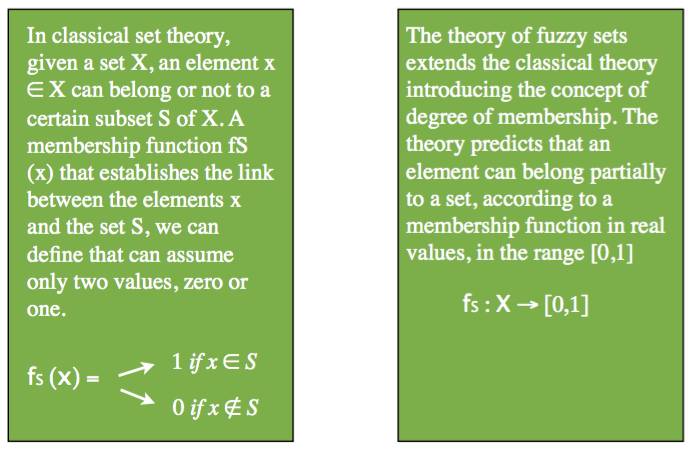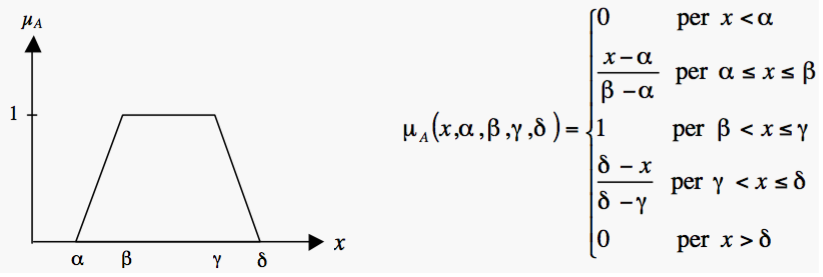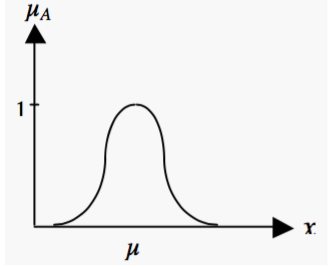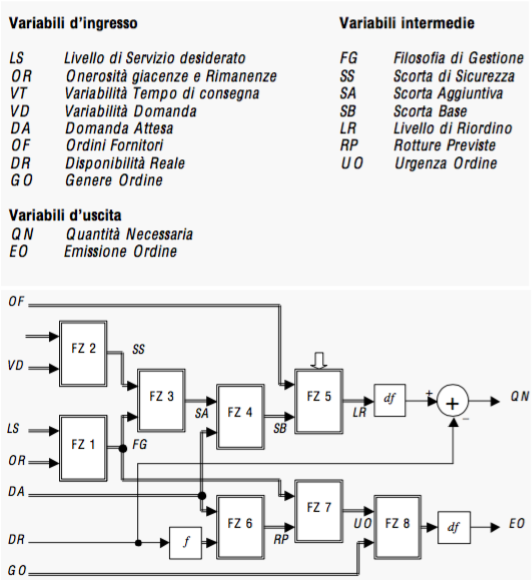An economic system organized that wants to increase own standard of efficiency, it must also to know how to steer towards innovative models of management and control. Personally I find very interesting model that I am going to describe here, called “fuzzy logic“.
Introduction to fuzzy logic
The theory of fuzzy logic was introduced in the ’60s by the American -Iranian engineer Lotfi Zadeh. It is based on the definition of “fade out” sets with the ultimate goal of obtaining a more realistic representation of sizes and concepts that are inherently gradual, not dichotomous. Fuzzy variables are language and not numerical, their values can be classified as high, low, cold and heat. It attempts to define the degree of membership, through a membership function, which in the Boulean logic can assume only two values: 0 or 1; whereas fuzzy logic can assume continuous values between 0 and 1, in a process that can be termed reverse compared to the post-industrial digital evolution. Fuzzy variables are similar to the human way of thinking and reasoning and are characterized by the use sometimes approximate rules, based on common sense or experience, but difficult to translate in analytical terms. That is why the theory of fuzzy decision criteria, refers to human linguistic and not mathematical rules in defining the way in which variables influence each other, without the use of formulas or complex analytical models. We can say that fuzzy systems behave satisfactorily in those situations which a person would know and handle easily, but which are the most difficult to deal with by analytical methods. They are particularly suitable to work in conditions of uncertainty and disturbances in data acquisition. They adapt well to time-varying or highly non-linear processes, and are therefore difficult to represent by mathematical models.
Use of Fuzzy Logic
Fuzzy logic-managed systems are rapidly expanding in many fields. There are mainly two areas of use: control systems and decision support systems.
In many fuzzy systems, the input variables are expressed with numerical values such as the value expressed by a sensor or the cost to support a certain decision-making alternative. A numeric value is often required for the answers that the system must provide, eg the level of expenditure or the level of rotation of a warehouse. In such situations, there is a need to use fuzzy reasoning and numbers, using operations of “fuzzification and defuzzification”, for translating a value associated with a number to a fuzzy value, and vice versa. At this stage, the process of fuzzy inference involved, is used to interface inputs with correct outputs, or to associate certain linguistic variables values of the input (antecedents) to the corresponding variables output values of linguistic (consequent).
The feature that differentiates the fuzzy decision support systems, compared to other analytical support models used in trade-off processes, lies in the conceptual advantage. However, while in analytical systems, according to a set of constraints, we try to find the alternative that maximizes some objective function, indeed the choice of the objective function and the definition of the constraints are a decisive outcome of the trial. In fuzzy logic, objectives and constraints are managed in the same way; both are expressed by the membership functions and the role they assume in the system is to be established by linguistic rules so that it is much easier to combine competing objectives and provide guidance to the system without having to decide if it should be used as constraints or objectives. This is an important advantage because it avoids the characteristic dichotomy of other analytical models, in which the objective function orders the alternatives according to a degree of preference, while the constraints restrict the space of the alternatives, especially in cases in which we wish to achieve different objectives, particularly if they are conflicting.
Classical theory vs. Fuzzy Theory
A fuzzy set S can be defined as a ordered pairs set constituted by the X elements and the corresponding value of the membership function: S = {(x, fS (x)) | x ∈ X}.
If the set X is continuous it can represent the fuzzy set S with the notation: S = ∫ X fS (x) / x; conversely, if X is discrete, we have: S = Σi mS (xi) xi.
The symbols ∫ and Σ indicates a union, while the symbol “/” represents a link between the membership value and the element to which it refers.
Membership Functions
Depending on application type, we can also define very different membership functions. In a set A and a function μ, the membership functions most used are:
Triangular membership function: defined by 3 parameters: the extremes α and γ and the point of maximum β.
Trapezoidal membership function: defined by 4 parameters: the extremes α and δ and the lower and higher values in the range from β to γ.
Bell-shaped membership function: can be obtained by the triangular function parameters, using parabola arcs instead of straight segments or with a Gaussian, setting the parameters μ and σ of the distribution.
A proper membership function choice is crucial in the development of fuzzy system, indeed the choice determines the characteristics of the processes of fuzzification and defuzzification of the inputs and outputs. The fuzzification allows us to calculate the input variable degree of membership to each fuzzy variable through the numerical value. The defuzzification allows us to calculate a output variable real value, starting from the result obtained by the fuzzy inference process.
Fuzzy rules
The fuzzy rules are the crossing point between empirical knowledge described above and their numerical processing. These rules are qualitative and constitute the formal system description. When they relate with the membership functions, they provide a purely numeric system model, on which we can work using a computer as well. A fuzzy rule is typically expressed with the construct “if-then” and it can present one or more antecedent and one or more consequential variables. A rule with one antecedent and one consequent it has the following form: if x is A then y is B.
A Fuzzy system structure
A fuzzy system consists of four basic units: the knowledge base and the three calculation units: fuzzification, inference and defuzzification.
The knowledge base contains all the information on the system, and it allows the other units to process the input data and obtain the outputs. This informations can be divided into data base and rule base. The database includes the description of all the variables with their membership functions, the rule based linguistic rules of inference.
The inference engine is the heart of the fuzzy system. It determines the state of the outputs in respect to a given configuration of the inputs, using the information contained in the knowledge base.
Defuzzification can be performed through various strategies; there is not one considered the best of all. The designer has to determine which is the best method with respect to the problem requirements. Among the several strategies most used are Maximum Method and the Barycenter Method. According to the Maximum Method the point of defuzzification is chosen where the whole output membership function reaches its maximum. If we have many maximum points, we can select: the first (first maximum method), the last (last maximum method) or their mean (average maximum method).
According to the Barycenter Method, also called the Centroid Method or the COG (Center Of Gravity) Method, the calculated value for the defuzzification is the one related to the barycenter abscissa of the figure formed by the membership function.
Case Study: The warehouse parts management of an airline
The introduction of innovative methods in the production area such as “just-in-time”, “lean-production” etc, has generated a dynamic view of business warehouses through the introduction of organizational models geared towards the quality increase in inventory management in order to reduce the direct and indirect operating costs which often make stock management costly and inefficient.
In aviation, often we can find rigid analytical criteria and empirical solutions based on employee backgrounds, so the development of an innovative control philosophy such as fuzzy logic can represent a revolution in terms of management costs, performance quality and safety.Before continuing in this business case, we have to associate the costs with stocks taking in consideration the criteria imposed by aviation rules Part M (annex I to the European Regulation (EC) 2042/2003 – 20 November 2003:
- fixed assets inventory costs: they are all the costs growing with stock increase, so we can consider them as proportional to the quantity, value, and storage time of the stocks. As a cost index we can use the mean value of the stock during the period. The main components of storage costs, ordered roughly in descending order of importance are: a) Capital opportunity cost tied up in inventory: it is the potential financial revenue which we forgone deciding to maintain a certain level of stock. It is calculated by estimating how much could be gained by investing in a different way the capital committed in stocks. As a minimum return we can consider the interest of a bank deposit, but business investments typically provide more revenue, so an estimate based on the MARR value is more realistic. b) Insurance costs: they are also proportional to the unit value of the product. c) Warehouse operating costs: they can be of many types and depend mainly on the physical characteristics of the product. We have: space occupied costs, utilities and logistic costs, labor costs for components and spare parts handling , etc.
- d) costs due to product obsolescence or parts limited life cycles: these are probably the most volatile costs. The Civil Aviation Authority rules require constant observation of spare parts in the stocks, especially in relation to LLP (Life Limited Parts), which must be periodically re-certified in terms of efficiency. Moreover, there are some parts related to avionics components which lose value over time. In these cases it is essential to guarantee a high stock rotation.
- Costs for order management: they generally increase when the stocks decrease. To maintain a low stock level needs frequent orders of small quantities.
- Costs for “broken stocks”: these are the costs and losses due to non-fulfillment for spare parts requested from technical management and the resulting state of airplane “on ground”. In this case indirect costs are: passenger re-protection, possible use of backup aircraft and resulting ferry flight and related costs, positioning of the technically certified team for the delivery of the airplane remaining on ground for more than 24 hours, etc. So we have to add up a considerable number of costs and this often becomes the Achilles’ heel of the airlines; frequently it is a decisive factor when declaring bankruptcy. These costs increase when the warehouse stocks decrease, because it is more likely to meet the demand peak, if the minimum stocks level is higher. These are the costs more difficult to quantify and predict, and for this reason, they are not included in the majority of management analytical models which usually take into consideration only the first two cost categories.
Fuzzy system design and structure
The design of the overall structure of the system of management of the spare parts is split into two interacting sections: the algebraic section to update the inventory, and the fuzzy section to determine the needs. The inventory update is then executed in a deterministic way, while the fuzzy logic is responsible for managing the problem of needs. The first section of the project, therefore, has no distinctive details, essentially it updates the inventory through a sequential process with respect to aviation rules. The section of the needs calculation is instead a real fuzzy system, consisting of several blocks of inference, as you can see in the graphic below which shows the characteristics with respect to the logical sequence of the design phases. There are eight input variables and two output variables. The selected variables are not the only ones worthy of interest but they can ensure the right balance between the two opposite requirements of completeness and simplicity. It is very important that significant variables are not neglected, but it is equally important that the system is not weighed down with insignificant variables and marginal blocks of calculation in design. Below the graphic design of the project and a description of the input, output and intermediate variables:
The fuzzy variables and the blocks are represented by the double lines, the simple variables and the algebraic operators are represented by the single lines. The input variables must always be subject to the operation of fuzzification which is implied for all variables except for the input variable (DR) used both as a fuzzy variable and numeric value. We can observe the two calculation paths leading to the two outputs: the first path determines the amount necessary to restore stocks (QN), the second decides whether it is appropriate to get an order (EO).
Determination of the required amount (QN)
This part of the system involves seven of the eight input variables. The requirement is decided according to: the actual situation of stocks, the consumption forecast, and a number of variables that tend to influence appropriately the amount of inventory. To understand the logical sequence of operations, it is appropriate to describe the operation going backwards, starting from the exit end arriving at the first calculation blocks and the input variables:
the output variable QN (required amount), which in this part of the system represents a numeric variable non-fuzzy, is calculated algebraically as the difference between the intermediate variable LR (re-order level) and the lower variable DR (stocks availability).
The output fuzzy of the first part of the system is the variable LR, which represents the amount to which the stock has to be restored. On this variable we must perform the defuzzification operation in order to obtain the numerical value to subtract from the actual availability amount.
In determining the reorganization level we have to consider the current orders, to avoid the risk for overestimating warehouse real needs. In the system, block 5 deals with this issue fixing the orders from suppliers (OF) currently in progress and the value of the stock based (SB) defined as the amount of net recovery of the orders in progress, determined in block 4 through the contribution of expected demand (DA), and the stock additional (SA).
The expected demand is a consumption estimate that we have during the lead time. It is calculated in block 3, starting from the variable management philosophy (FG) and the value of the safety stock (SS), the outputs of the first two blocks fuzzy.
In block 1 inputs consist of two variables desired service level (LS) and burden of stocks and inventories (OR). These are directly linked to business strategy, as they affect the management philosophy, determining the additional stock and the order urgency.
Block 2 determines the variable safety stock (SS) introduced to ensure a margin of error in the estimates. The inputs of the block are the variability of demand (VD) and variability of delivery time (VT), they both influence the management, considering the level of uncertainty inherent in the decision-making process.
In conclusion we can certainly say that the fuzzy models, particularly in some aviation situations, can really represent a significantly innovative output. I think in some business models with a high density of exogenous variables such as aviation, the chance to get out of the dichotomy: alternative/constraints can be a great support in the pursuit of a greater level of efficiency and effectiveness.





